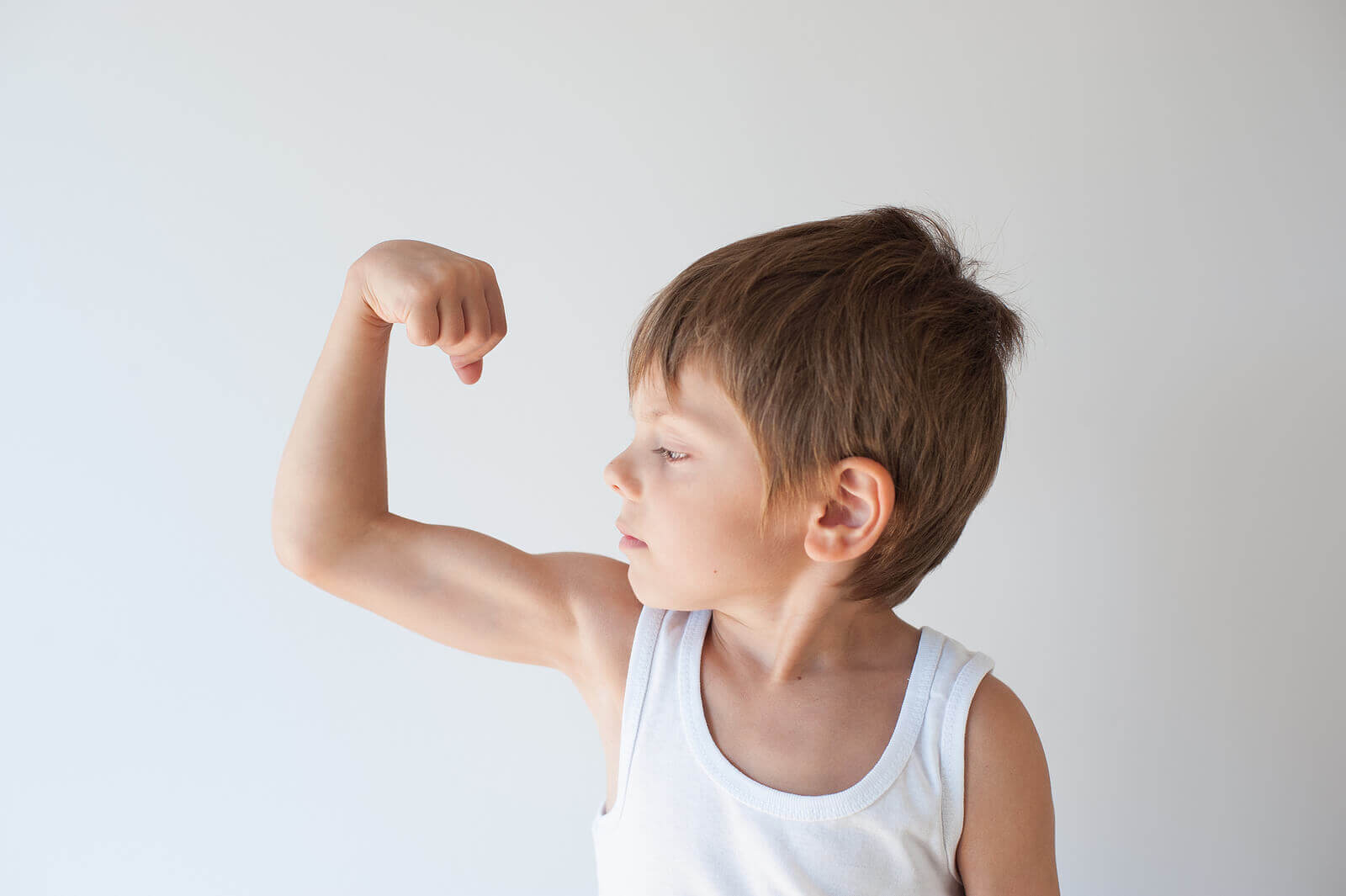Myths about Physical Strength Training in Children and Adolescents

The physical strength training of children and adolescents is surrounded by myths, especially when it comes to physical strength exercises. But it’s not a matter of blaming people for this, as until a few years ago, the information on the subject was very limited.
However, over time experts have been able to clarify various aspects related to strength training in minors. And this is why some statements have gone from being “irrefutable truths” to simple popular myths.
Despite having the support of scientific research, in some cases, there are those who oppose strength training in children and adolescents because they still believe the false claims. Today, we’ll tell you the truth about physical strength training in children and adolescents.
Physical strength training in children and adolescents
Physical strength training in children and adolescents is marked by erroneous thoughts, which are fed by the lack of information, the stubbornness of parents, or the lack of training of some teachers.
Within this series of false statements, those related to the stimulation of strength in minors stand out. This type of exercise is viewed by the elderly with great fear, especially when working with external loads, such as weights, bars, or other similar elements.
However, the training of all physical capacities is essential for the adequate psychomotor development of the human being. In fact, physical stimulation from an early age builds the foundations for sports life in adulthood. For this reason, it’s important to include strength training from childhood.

Myths regarding strength training in children and adolescents
As mentioned above, the lack of information and ignorance about the subject contribute to the construction of popular myths around the practice. These are associated with the negative aspects of this discipline and the fear parents have of harming their children if they encourage it.
Below, we’ll tell you the most common myths associated with resistance exercise in children so that you can identify them and understand why you should forget about them today.
Myth #1: It favors the appearance of physical injuries
The most common negative thinking around strength training in children concerns injuries. In general, parents believe that this type of exercise increases the probability of damaging the bone or muscle structures of minors.
Based on this belief, many adults oppose the inclusion of strength training in their children’s sports routines.
The truth is that the probability of suffering an injury is always latent, in any activity and at any age. But, fortunately, the risk of suffering an injury is reduced when there’s adequate planning and control in the execution of this routine.
Myth #2: Physical strength training stunts growth
Another of the most recognized myths that have to do with strength training in children is associated with interference in the growth process.
Very often, people say that those under 15 years of age who practice this type of training alter their final size. Even more so, when using external loads, such as dumbbells or weightlifting bars.
However, properly planned and properly executed strength training shouldn’t negatively influence the child’s physical development.
In fact, strength training in children and adolescents favors the integral development of the person. In addition, it contributes to the strengthening of bone, muscle, and joint structures, which are key factors in the growth process.
Myth #3: It accelerates the loss of flexibility
Flexibility is another of the physical capacities of the human being and as such, it must be worked on and stimulated along with the rest. This doesn’t mean that if strength is trained, flexibility is affected. In fact, the opposite is true, as the combination of strength and flexibility exercises enhances both physical capacities at the same time.
Myth #4: Strength training can be done in any setting
Another common myth that’s related to physical strength training in children and adolescents refers to the context within which this training is carried out.
In general, adults who are in favor of this practice believe that the environment and the elements used are secondary factors and that they don’t have any influence on the result. But this belief is wrong, as the experience of a mature body can’t be extrapolated to that of a developing child.
The main objective of this type of training in minors is the development of physical strength. And for this, it must take place in controlled environments, with the appropriate elements and, above all, with the appropriate planning, relative to their age and abilities.

The truth about physical strength training in children and adolescents
The idea of this article is to clarify the erroneous thoughts that many have regarding physical training in children and adolescents. Above all, regarding the stimulation of strength.
Despite everything we’ve said about this type of training during childhood, this doesn’t mean that the proper precautions shouldn’t be taken or that you don’t need to follow the recommendations of professionals.
Ideally, children shouldn’t use external loads with exaggerated weights, nor do exercises that can cause disc injuries.
We recommend turning to a group of professionals in order to plan adequate strength training for your children.
The physical strength training of children and adolescents is surrounded by myths, especially when it comes to physical strength exercises. But it’s not a matter of blaming people for this, as until a few years ago, the information on the subject was very limited.
However, over time experts have been able to clarify various aspects related to strength training in minors. And this is why some statements have gone from being “irrefutable truths” to simple popular myths.
Despite having the support of scientific research, in some cases, there are those who oppose strength training in children and adolescents because they still believe the false claims. Today, we’ll tell you the truth about physical strength training in children and adolescents.
Physical strength training in children and adolescents
Physical strength training in children and adolescents is marked by erroneous thoughts, which are fed by the lack of information, the stubbornness of parents, or the lack of training of some teachers.
Within this series of false statements, those related to the stimulation of strength in minors stand out. This type of exercise is viewed by the elderly with great fear, especially when working with external loads, such as weights, bars, or other similar elements.
However, the training of all physical capacities is essential for the adequate psychomotor development of the human being. In fact, physical stimulation from an early age builds the foundations for sports life in adulthood. For this reason, it’s important to include strength training from childhood.

Myths regarding strength training in children and adolescents
As mentioned above, the lack of information and ignorance about the subject contribute to the construction of popular myths around the practice. These are associated with the negative aspects of this discipline and the fear parents have of harming their children if they encourage it.
Below, we’ll tell you the most common myths associated with resistance exercise in children so that you can identify them and understand why you should forget about them today.
Myth #1: It favors the appearance of physical injuries
The most common negative thinking around strength training in children concerns injuries. In general, parents believe that this type of exercise increases the probability of damaging the bone or muscle structures of minors.
Based on this belief, many adults oppose the inclusion of strength training in their children’s sports routines.
The truth is that the probability of suffering an injury is always latent, in any activity and at any age. But, fortunately, the risk of suffering an injury is reduced when there’s adequate planning and control in the execution of this routine.
Myth #2: Physical strength training stunts growth
Another of the most recognized myths that have to do with strength training in children is associated with interference in the growth process.
Very often, people say that those under 15 years of age who practice this type of training alter their final size. Even more so, when using external loads, such as dumbbells or weightlifting bars.
However, properly planned and properly executed strength training shouldn’t negatively influence the child’s physical development.
In fact, strength training in children and adolescents favors the integral development of the person. In addition, it contributes to the strengthening of bone, muscle, and joint structures, which are key factors in the growth process.
Myth #3: It accelerates the loss of flexibility
Flexibility is another of the physical capacities of the human being and as such, it must be worked on and stimulated along with the rest. This doesn’t mean that if strength is trained, flexibility is affected. In fact, the opposite is true, as the combination of strength and flexibility exercises enhances both physical capacities at the same time.
Myth #4: Strength training can be done in any setting
Another common myth that’s related to physical strength training in children and adolescents refers to the context within which this training is carried out.
In general, adults who are in favor of this practice believe that the environment and the elements used are secondary factors and that they don’t have any influence on the result. But this belief is wrong, as the experience of a mature body can’t be extrapolated to that of a developing child.
The main objective of this type of training in minors is the development of physical strength. And for this, it must take place in controlled environments, with the appropriate elements and, above all, with the appropriate planning, relative to their age and abilities.

The truth about physical strength training in children and adolescents
The idea of this article is to clarify the erroneous thoughts that many have regarding physical training in children and adolescents. Above all, regarding the stimulation of strength.
Despite everything we’ve said about this type of training during childhood, this doesn’t mean that the proper precautions shouldn’t be taken or that you don’t need to follow the recommendations of professionals.
Ideally, children shouldn’t use external loads with exaggerated weights, nor do exercises that can cause disc injuries.
We recommend turning to a group of professionals in order to plan adequate strength training for your children.
All cited sources were thoroughly reviewed by our team to ensure their quality, reliability, currency, and validity. The bibliography of this article was considered reliable and of academic or scientific accuracy.
- Peña, G. Et al. (2016). Iniciación al entrenamiento de fuerza en edades tempranas: revisión. Revista Andaluza de Medicina del Deporte. Disponible en: https://scielo.isciii.es/scielo.php?script=sci_arttext&pid=S1888-75462016000100009
- Comité Nacional de Medicina del Deporte Infantojuvenil. (2016). Entrenamiento de fuerza en niños y adolescentes: beneficios, riesgos y recomendaciones. Archivos argentinos de pediatría. Disponible en: https://www.sap.org.ar/uploads/consensos/consensos_entrenamiento-de-la-fuerza-en-ninos-y-adolescentes-beneficios-riesgos-y-recomendaciones-80.pdf
This text is provided for informational purposes only and does not replace consultation with a professional. If in doubt, consult your specialist.








